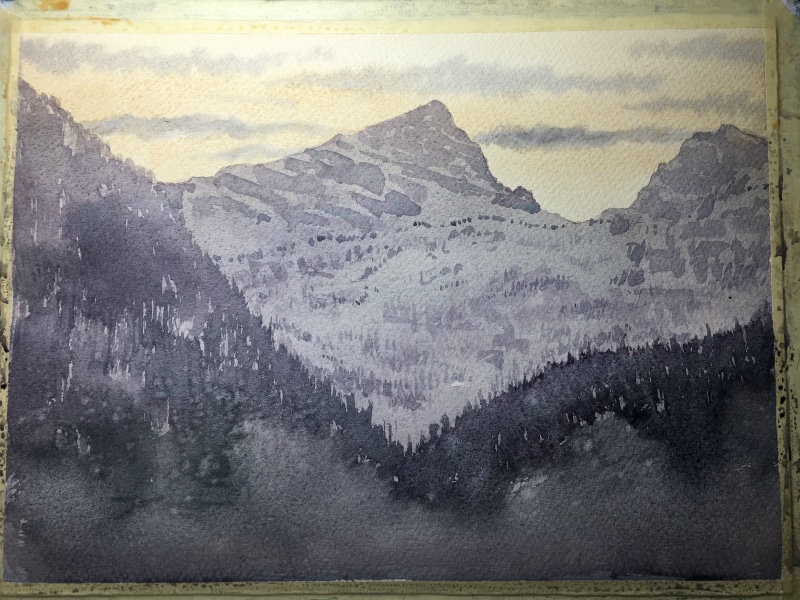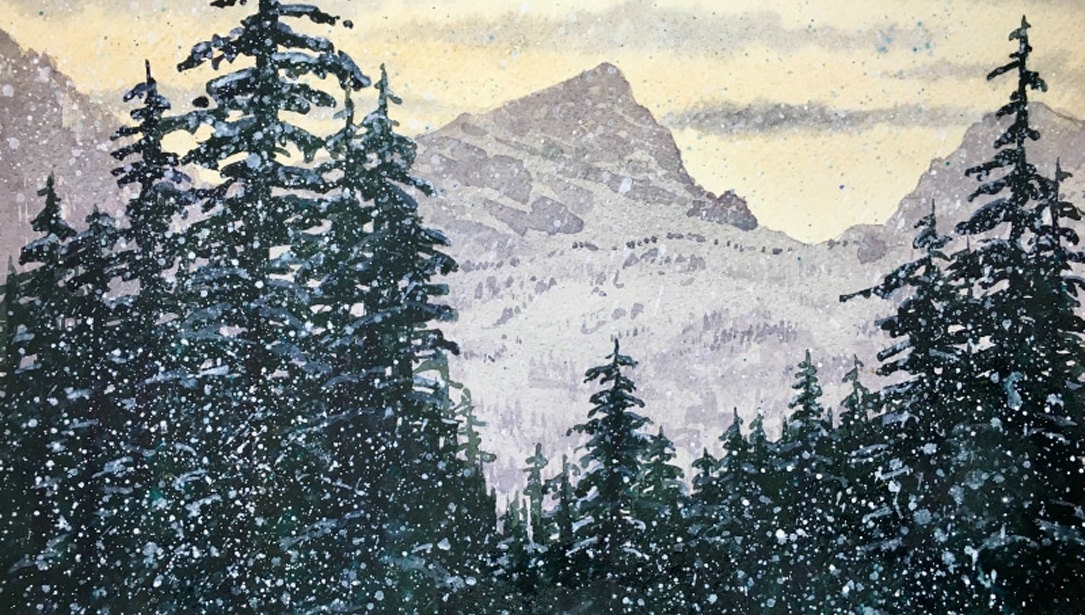Share:
Painting mountain landscapes can be daunting. Where to start, what colors, how much detail, which brush…the list can go on and on. In this article I will take a winter mountain scene and break it down into easily approachable steps – washes, developing layers and even a few special effects.
I grew up on the west coast and have always been drawn to the landscapes of the Pacific Northwest. The Vancouver Island Ranges, home to Mount Washington ski resort, were just a short drive away. I have fond memories of going skiing up there on family trips, both as a kid with my parents and later as a parent with kids of my own. Early morning light with soft shadows on the jagged mountainside, combined with a light snowfall provided by some incoming clouds create a peaceful winter palette that I’ll try to recreate here.
Over the last few years, I have worked hard to minimize the steps I use to make my watercolor paintings. I had a tendency to get very detail-oriented and that wound up in very tight paintings I was generally not happy with. Keeping the steps to a minimum has helped reduce the temptation to go back in with my brush to work and rework areas. This has also helped produce fresher looking washes, since the paints are left alone and given a chance to do their thing.

Before I even add a brushstroke, I select my main trio of colors. Rather than think about colors from a primary triad point of view, I will generally choose a light, a middle and a dark to develop the overall tone:
Light: French Ochre is a lovely earth yellow that is not only perfect for conveying morning light, but it also provides some lovely granulation on the rough paper I used for this painting.
Middle: Moonglow is a very versatile mixture that I felt would be perfect for the mountain washes and also stay transparent enough for the French Ochre to come through in the mountain tops. When left to develop, the colors that make up Moonglow will also settle in to the grooves of the rough paper, revealing different color variances throughout the wash.
Dark: Perylene Green has been a go-to dark for me for some time. In this painting, it really helped send the foreground trees right to the front.
Starting with the lightest washes, I began this painting with the sky. Using clean water and a large brush, I wet the base of the mountain tops. Turning the support upside down, I applied a wet wash of French Ochre just below the area I brushed with clear water and I work the yellow up in to the moistened area. I then reload the brush and work down form the initial area of yellow to the top (actually the bottom) of the painting.
For the clouds, I add some water to Lavender until it was a nice thick creamy texture. I darkened it with a touch of Moonglow – and while the sky still had some sheen to it, I scrubbed in the Lavender mixture to form the clouds and left to dry completely. TIP – Keeping the paint mixture thick and creamy helps it to stay put on the wet sky wash. The clouds will still soften, but it won’t spill out all over the place. Also try using a cut up fan brush to put in the clouds. Brush the color in quickly and then LEAVE IT ALONE. Resist the temptation to go back and rework the clouds.

For the base wash on the mountains, I mixed up a very light wash of Moonglow and worked from the mountain tops down to the bottom. It is important to mix up a very large batch of your color so you have enough to cover the entire area. Having said that, I will still add a little more pigment or water here and there to vary things up a little, so I don’t end up with a completely flat wash. This helps build some implied texture for the snow. Then this is left to dry completely.

Building with another layer of Moonglow that is only slightly darker than the previous wash, I quickly add the texture of the rocky mountain face, as well as some of the tree textures on the distant hills. I added just a hint of Perylene Green to this wash and working left to right, I create the mid-ground tree line, working it all the way down to the bottom. While still wet, I used a fan brush to splatter in a little clean water to break the wash up a little and leave the whole painting to dry completely again.

For my first pass on the foreground trees, I mix up a large batch of Perylene Green with a bit of Cascade Green. I use a very large rigger brush and start with the tallest peaks, working each peak concurrently as I progress from top to bottom. This forces me to work quickly and keep my brush strokes loose and free. Once the wash has reached the bottom and is still wet, I quickly drag in some thick Neutral Tint to form tree trunks and then I splatter in some thick Cobalt Teal Blue that helps to break the wash up a little by adding some texture and also helping to lighten the wash a bit, then this is left to dry.

Snowfall by Ian de Hoog
For the final touches, I reused the dark wash from the previous step and add more depth to the foreground trees. Once this has dried, I mixed up some thick Chinese White and spatter that on in successive layers to create the feeling of a light snowfall. While this is drying, I lightly painted in some snow on the trees – not intending it to stand out, but to dry just slightly lighter than the trees and add some additional texture.
DANIEL SMITH Watercolors used:
French Ochre
Moonglow
Perylene Green
Cobalt Teal Blue
Lavender
Neutral Tint
Cascade Green
Chinese White







